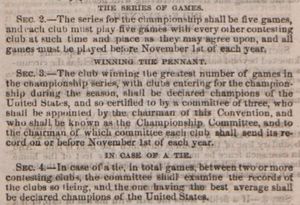1872.1: Difference between revisions
No edit summary |
No edit summary |
||
| Line 3: | Line 3: | ||
|Year Suffix= | |Year Suffix= | ||
|Year Number=1 | |Year Number=1 | ||
|Headline= | |Headline=NABBP Refines Rules for Home and Away Series | ||
|Salience=1 | |Salience=1 | ||
|Location=League Rules | |||
|Location= | |||
|Country=United States | |Country=United States | ||
|Coordinates= | |Coordinates=37.09024, -95.712891 | ||
|State= | |State= | ||
|City= | |City= | ||
|Modern Address= | |Modern Address= | ||
|Game=Base Ball | |Game=Base Ball, | ||
|Immediacy of Report=Contemporary | |Immediacy of Report=Contemporary | ||
|Age of Players=Adult | |Age of Players=Adult | ||
|Holiday= | |Holiday= | ||
|Notables= | |Notables= | ||
|Text=<p>" | |Text=<p>" Sec. 2 -- THE SERIES OF GAMES: . . . each club shall play five games with every other contesting club . . . before November of each year . . .</p> | ||
<p>Sec.3 -- WINNING THE PENNANT: The club wining the greatest number of games in the championship series . . . shall be declared champions of the United States . . .</p> | |||
<p> | <p>Sec.4 -- IN CASE OF A TIE: In case of a tie . . . the one having the best average shall be declared champions . . . .</p> | ||
<p> | |Sources= | ||
|Sources= | |||
|Warning= | |Warning= | ||
|Comment=<p | |Comment=<p>Richard Hershberger Explains, 3/5/2022:</p> | ||
<p><span>"150 years ago in baseball: More on the NAPBBP's annual convention. Here is an excerpt from the new championship rules.</span><br /><br /><span>Notice that not only does each entrant play a five game series against every other, but the rule specifies that they will play all five games. This is new. The understanding last season was that a series was, by its nature, a "best of" matter. So a five game series might actually only be three games, if one team won all three. This created a potential discrepancy between a team winning the most series and a team winning the most games. That potential discrepancy has, in theory, been resolved. If every team plays out their entire series, the team winning the most games will also win the most series.</span><br /><br /><span>But this is 1872. No one imagined that every game would actually be played. This is implicitly acknowledged by using win-loss average as a tie breaker, should the two clubs at the top of the standings have the same number of wins. If all the games were played, their averages would also be tied. This seems to have been thought so unlikely that no additional tie breakers were necessary. It will be the 1880s before the modern system is adopted, with win-loss percentage determining the pennant, rather than being merely a tie breaker.</span><br /><br /><span>The championship rules are clearer this year than last, when there was genuine confusion about how they worked. This does not mean, however, that all the problems were resolved. There is still a ticking time bomb. Stay tuned. Beadle's Dime Base Ball Player 1872" </span></p> | |||
<p | <h3><span id="Create_Account" class="mw-headline"> </span></h3> | ||
< | |||
|Query= | |Query= | ||
|Source Image= | |Source Image=1872 playoff rules.jpg | ||
|External Number= | |External Number= | ||
|Submitted by=Richard Hershberger | |Submitted by=Richard Hershberger | ||
|Submission Note=FB | |Submission Note=FB Posting, 3/5/2022 | ||
|Reviewed=Yes | |Reviewed=Yes | ||
|Has Supplemental Text=No | |Has Supplemental Text=No | ||
}} | }} | ||
Revision as of 07:59, 5 March 2022
| Prominent Milestones |
| Misc BB Firsts |
| Add a Misc BB First |
| About the Chronology |
| Tom Altherr Dedication |
| Add a Chronology Entry |
| Open Queries |
| Open Numbers |
| Most Aged |
NABBP Refines Rules for Home and Away Series
| Salience | Prominent |
|---|---|
| Tags | |
| Location | League RulesLeague Rules |
| City/State/Country: | United States |
| Modern Address | |
| Game | Base BallBase Ball |
| Immediacy of Report | Contemporary |
| Age of Players | AdultAdult |
| Holiday | |
| Notables | |
| Text | " Sec. 2 -- THE SERIES OF GAMES: . . . each club shall play five games with every other contesting club . . . before November of each year . . . Sec.3 -- WINNING THE PENNANT: The club wining the greatest number of games in the championship series . . . shall be declared champions of the United States . . . Sec.4 -- IN CASE OF A TIE: In case of a tie . . . the one having the best average shall be declared champions . . . . |
| Sources | |
| Warning | |
| Comment | Richard Hershberger Explains, 3/5/2022: "150 years ago in baseball: More on the NAPBBP's annual convention. Here is an excerpt from the new championship rules. Edit with form to add a comment |
| Query | Edit with form to add a query |
| Source Image | |
| External Number | |
| Submitted by | Richard Hershberger |
| Submission Note | FB Posting, 3/5/2022 |
| Has Supplemental Text |
Comments
<comments voting="Plus" />

